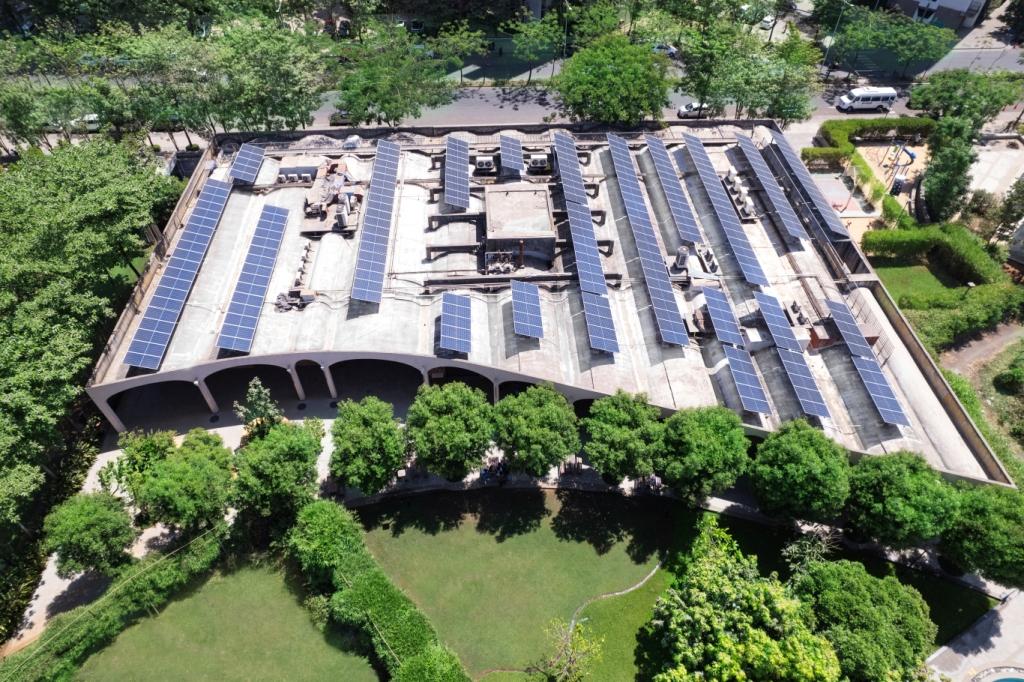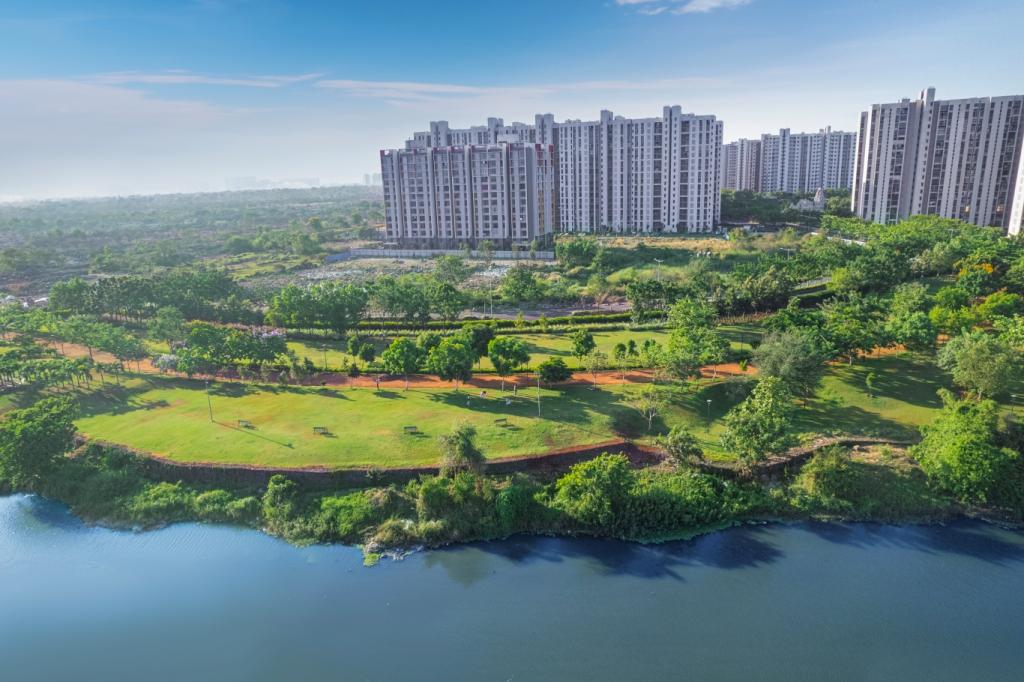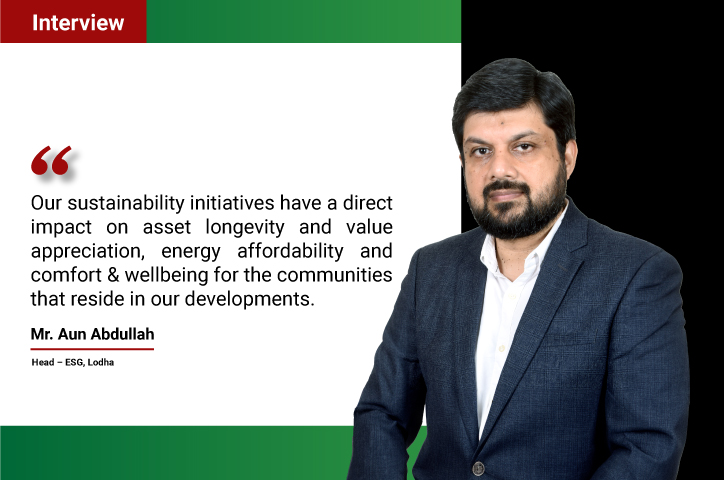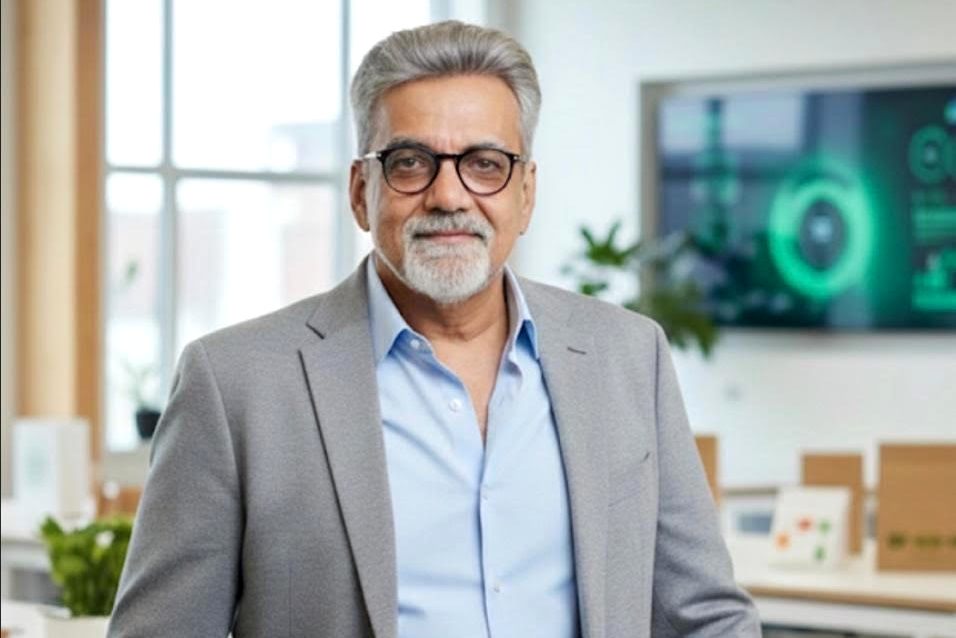Real estate developer Lodha recently celebrated a significant milestone by achieving carbon neutrality in its operations for scope 1 and 2 emissions. This accomplishment marks a pivotal step toward the company's ambitious goal of becoming net-zero carbon by 2050. Over the period from FY20 to FY24, Lodha substantially increased its reliance on renewable energy sources, a key factor contributing to its carbon reduction strategy.
In an exclusive interview with TheCSRUniverse, Mr. Aun Abdullah, Head - ESG, Lodha, sheds light on the innovative strategies and technologies that underpinned these achievements. He discusses the challenges faced, solutions implemented, and outlines Lodha's future plans to further curtail emissions. Mr. Abdullah underscores Lodha's commitment to sustainability, emphasizing its holistic approach that prioritizes community well-being, asset durability, property values, and energy affordability.
Additionally, Mr. Abdullah elaborates on the broader impact of Lodha's decarbonization initiatives. He highlights their potential to stimulate job creation, foster growth in related industries, and contribute significantly to India's economic development. By spearheading advancements in renewable integration, promoting high-efficiency systems, and nurturing a climate-conscious design ecosystem, Lodha is not only reducing environmental impact but also catalyzing the demand for greener, climate tech jobs. This proactive approach not only supports sustainable development but also positions India at the forefront of global climate tech innovation.
This conversation offers valuable insights into Lodha's comprehensive sustainability framework, encompassing environmental, social, and economic considerations.
Scroll down to read the full interview.
Q&A
Q. What strategies and technologies did Lodha use to reduce scope 1 and 2 emissions, and how does it plan to address remaining emissions?
A. Our Scope 1 and 2 emissions have been reduced by approximately 75% from the baseline year of FY22, largely due to our transition to renewable energy sources for our electricity requirements. Additional emission reduction strategies include enhancing efficiency, electrifying equipment and vehicles, switching to lower and ultimately zero Global Warming Potential (GWP) refrigerants, and complete renewable integration.
We have been able to reduce the Scope 1 and 2 emissions significantly and continue to reduce them further. However, some emissions still remain that cannot be eliminated due to market and technological limitations in areas like complete removal of standby DGs or deploying zero GWP refrigerants, for that we invest in carbon credits to offset these remaining emissions. By investing in these carbon credits, we're not only mitigating our environmental impact earlier but also contributing to local economies and environmental conservation. These efforts are a testament to our holistic approach to sustainability, recognizing the interconnectedness of environmental, social, and economic factors.
Q. Can you elaborate on the types of renewable energy sources Lodha utilizes in construction activities and for owned assets?
A. We are using a mix of on-site and off-site options. We have 1.6MWp of on-site solar plants catering to our operating requirements. In addition to that, we have recently reverse auctioned our first open access plant of 6.5MWp capacity. As renewable integration is dependent significantly on regulations, and has constraints of space and minimum load thresholds, we also overcome such challenges through Green Tariffs and I-RECs.

Q. What challenges did Lodha face in increasing its share of renewable electricity, and how were they overcome?
A. The primary challenges are regulations, space constraints, and time horizon related to a construction project. It is not always viable to set up an onsite plant for a project that has a horizon only of a couple of years, plus in several instances, there is not enough unobstructed or unshaded space available for the duration of the plant’s service life. Similarly, regulations put minimum and maximum load thresholds for various integration possibilities which further limits the options. However, we do note and welcome that significant policy improvements have been brought out by the government, especially Green Energy Open Access, Group Net Metering, among others, that are targeted to overcome these particular challenges, and a faster implementation will be of great benefit to everyone.
Q. Building on achieving carbon neutrality in operations, how does Lodha plan to address Scope 3 emissions and further improve its overall sustainability in the coming years?
A. Our flagship initiative, Lodha Net Zero Urban Accelerator, is particularly focused on decarbonizing scope 3 emissions. At the Accelerator, in partnership with RMI, we are working on decarbonizing the entire carbon emissions spectrum of the built environment. Following is how we are tackling our Scope 3 emissions:
Decarbonising our Supply Chain (Scope 3 Emissions – Upstream)
Our decarbonisation strategy underscores the importance of reducing emissions from purchased goods and services, which currently account for 40.1% of our total emissions. This number largely comes from the materials used in construction, such as cement, concrete, steel, aluminium, blockwork, tiles, paints, and others. These components are major contributors to the overall carbon footprint of building projects due to their intensive production processes and widespread use.
We conducted a detailed benchmarking exercise to measure the embodied carbon associated with our construction materials and to ascertain their proportion in typical project constructions. This evaluation serves as a baseline for our ongoing efforts to decrease carbon intensity through strategic interventions and innovative techniques, specially oriented towards the top contributing materials.
Our commitment extends to the adoption of alternative, low-carbon materials such as green concrete mixes and recycled Steel and Aluminium, and other materials that have higher recycled content.
Furthermore, we prioritise efficient and optimised design approaches that promote dematerialization, enhance circularity, and minimise waste during construction processes. By continuously evaluating and transitioning to a supply chain characterised by efficient production processes and a high percentage of recycled content, we aim to further minimise our environmental impact.
Some examples:
- We topped out a 23-storey building, using a triple blend concrete mix (OPC, Fly Ash, GGBS) with up to 47% Cement (OPC) replacement with GGBS (Ground Granulated Blast Furnace Slag) - a low carbon alternate resulting in an outstanding 36.75% reduction in embodied carbon compared with conventional concrete mix.
- We recently partnered with IIT-Delhi for piloting use of an innovative blend, LC3 (limestone calcined clay cement) to find a commercial use case; this blend can help achieve up to 40% reduction in emissions compared to Ordinary Portland Cement (OPC). Preliminary trials have been completed and we expect the pilot to be completed within FY25
Energy used in our projects (Scope 3 Emissions – Downstream)
Emissions associated with the energy used by residents in our developments account for approximately 57.3% of our total emissions. Our strategies to reduce the carbon intensity in this category include reducing energy demand through climate-conscious passive designs measures, integrating nature-based solutions for urban cooling, promoting adoption of super-efficient equipment, conducting customer awareness programs, and facilitating the transition to renewable energy sources.
Some examples:
 Efficient Designs: At the heart of our approach is a keen focus on optimising architectural elements during the design stage. By carefully considering the orientation, window-to-wall ratio, natural ventilation, shading, and glass selection, we have been able to consistently enhance the environmental efficiency of our developments. We have used a high-performance single-layer glass at one of our recent parcels (Premier) at the Palava project that will cut down heat gains and energy needs while enhancing the comfort of the residents. We track the performance improvements of such initiatives post-occupancy and calibrate their larger deployment through field learning and positive feedback.
Efficient Designs: At the heart of our approach is a keen focus on optimising architectural elements during the design stage. By carefully considering the orientation, window-to-wall ratio, natural ventilation, shading, and glass selection, we have been able to consistently enhance the environmental efficiency of our developments. We have used a high-performance single-layer glass at one of our recent parcels (Premier) at the Palava project that will cut down heat gains and energy needs while enhancing the comfort of the residents. We track the performance improvements of such initiatives post-occupancy and calibrate their larger deployment through field learning and positive feedback.
Market Transformation: Recognising how efficient equipment can greatly reduce energy consumption in Indian households, and with projections showing that space cooling could account for up to 45% of household electricity use by 2050, we have proactively updated our procurement policies accordingly. Our commitment now includes the installation of BEE 5-star rated air conditioners and fans across most of our developments. To date, we have installed approximately 30,000 5-star rated air conditioners, equivalent to around 40,000 tonnes of cooling capacity, across our projects. This is the highest penetration of 5-star air conditioning at scale in the country and has been possible due to economies of scale achieved due to our volumes.
Q. What role do you see for innovation and technology in Lodha's future sustainability efforts, and are there any specific examples of upcoming projects or initiatives that exemplify this commitment.
A. Innovation is critical, simply because we need to break that status quo that's basically brought us here. We have a pilot and scale philosophy at the Accelerator, as we believe that the correct steps to enable innovation is to help build confidence around it, through field testing and pilot implementation, which also helps to fine-tune the solution that can then be taken to market and scaled. As you would have seen in the earlier answer, we boldly try out new technologies, but we have a robust framework to ensure quality and performance before scaling up. Some additional examples:
Global Cooling Prize: This international competition, which concluded successfully in April 2021, has spurred the development of air conditioning units that are substantially more efficient than traditional models and have a significantly lower climate impact. At Palava, we are currently conducting tests on these state-of-the-art air conditioners to establish new performance benchmarks that reflect real-world conditions. It will help such technology demonstrate application viability, can guide policy and regulations, and be ready for mass deployment in the near future.
We have forged a strategic partnership with D3, the start-up incubator arm of the Rocky Mountain Institute (RMI). This collaboration is designed to harness the creativity and ingenuity of start-ups, providing them with the support and resources needed to develop practical and cross-cutting technologies. Our joint efforts focus on accelerating the adoption of advanced climate technologies that can significantly impact energy efficiency and sustainability within the real estate sector. By supporting these innovative start-ups, we aim to integrate cutting-edge solutions into our projects, enhancing our environmental stewardship while driving toward our sustainability goals.
Q. Given Lodha's success, what specific measures can the broader real estate industry adopt to achieve similar reductions in carbon footprint?
A. The real estate industry should start with their GHG inventory, once that is in place the gaps in the three core areas of materials, operations, and products will automatically show themselves up. Thereafter, strategies can be built to decarbonize each area, starting with the low hanging fruits and then eventually transforming how we build with bringing climate and environment at its core.
It is also important for the real estate industry to develop capacity, not only within the developer ecosystem but also designers and supply chain which will help galvanize action from all sides and will reduce conservatism which inhibits people moving in this direction. It is also needed to inform the larger audience about the real impact of climate change on the growth prospects of our country and how our acknowledgment and addressing of climate risks makes business sense along with the moral imperative that it is.
Q. Can you elaborate on the potential domino effect of Lodha's decarbonization initiatives, such as job creation, growth in related industries, and its contribution to India's economic development?
A. We believe that our efforts, all the way from renewable integration to trying newer materials or promoting newer high efficiency systems and evolving the designer ecosystem towards a more climate conscious approach is consistently building capacity in the ecosystem and is paving way for demand for more greener and climate tech jobs.
India's economic development will be led by high-value, high-impact sectors of the future, and climate tech is definitely one among them. Moreover, climate tech also helps derisks India’s growth from climate challenges while opening newer opportunities for India to become a leader in this section of the industry. Overall, it's a win-win approach for India’s workforce and economy.
Q. How can these learnings be disseminated across the real estate sector?
A. Our Accelerator intends to share our work with the larger ecosystem through the availability of the content on our website and also through the publication of our annual digest, we hope that interested practitioners can refer them to develop their own strategies.
Q. How does Lodha ensure that its sustainability initiatives also benefit local economies and communities? Can you provide specific examples of such contributions?
A. Our sustainability initiatives have a direct impact on asset longevity and value appreciation, energy affordability and comfort & wellbeing for the communities that reside in our developments. It also helps in terms of enabling the supply chain transition towards a low-carbon economy further boosting employability and impact.
For community upliftment, there are various initiatives implemented both, at the community and national level. Our core pillars for social impact are education and women empowerment. As part of the education portfolio, we have eight schools across Mumbai in which we provide quality education to all segments of society. We also have our flagship national-level program, Lodha Genius Programme, in partnership with Ashoka University. As part of this, we support the brightest students from across the country to reach their full potential and contribute meaningfully back to society. For women empowerment, we run the Unnati initiative, in which our vision is to get more women into the formal workforce, ideally with jobs within a 30-minute radius of their homes.
Through this initiative, we have touched hundreds of women in upskilling and seeking sustainable, hyperlocal employment.
Q. What is Lodha's roadmap for becoming a net-zero carbon company by 2050?
A. Our net zero goals are validated by SBTi and are as follows:
 Near term targets:
Near term targets:
• Reduce absolute scope 1 and 2 GHG emissions 97.9% by FY2028 from a FY2022 base year
• Reduce scope 3 GHG emissions 51.6% per square meter of area developed by FY2030 from a FY2022 base year
Long- term net zero targets, aligned with 1.5°C goal:
• Achieving net-zero across scope 1, 2 and 3 emissions by FY2050
• These targets align closely with the 1.5°C goal set forth in the Paris Agreement, essential in mitigating the impacts of global warming and climate change.
Regarding our larger net zero roadmap, we invite the reader to refer https://www.lodhagroup.in/lodha-roadmap-to-net-zero/





 Efficient Designs: At the heart of our approach is a keen focus on optimising architectural elements during the design stage. By carefully considering the orientation, window-to-wall ratio, natural ventilation, shading, and glass selection, we have been able to consistently enhance the environmental efficiency of our developments. We have used a high-performance single-layer glass at one of our recent parcels (Premier) at the Palava project that will cut down heat gains and energy needs while enhancing the comfort of the residents. We track the performance improvements of such initiatives post-occupancy and calibrate their larger deployment through field learning and positive feedback.
Efficient Designs: At the heart of our approach is a keen focus on optimising architectural elements during the design stage. By carefully considering the orientation, window-to-wall ratio, natural ventilation, shading, and glass selection, we have been able to consistently enhance the environmental efficiency of our developments. We have used a high-performance single-layer glass at one of our recent parcels (Premier) at the Palava project that will cut down heat gains and energy needs while enhancing the comfort of the residents. We track the performance improvements of such initiatives post-occupancy and calibrate their larger deployment through field learning and positive feedback. Near term targets:
Near term targets:






.jpg)




